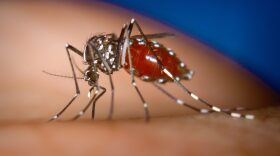The state Department of Education dedicated a new space observatory at Waipahu High School this week.
Students enrolled in a college-level astronomy course can use a 17-inch telescope located on the school's campus. The telescope is housed in a 12.5-foot dome atop one of the school's buildings.
The observatory allows students to remotely observe and capture images in color and infrared.
Waipahu High students can receive high school and college credits through the school's Early College program. The school has partnered with Leeward Community College and the University of Hawaiʻi since 2012.
The DOE's Early College program started at Waipahu High in 2012, with financial help from the McInerny Foundation. Since its inception, the program has expanded to offer more than 80 college-level courses at Waipahu High School, and has expanded to several other public high schools.
One of the first courses offered through the program is Astronomy 295. Students enrolled in this course will be able to use the new observatory to further enhance their education through research.
"In the spring of 2021, we had six Waipahu High School early college students and six Odyssey early college students from Colorado Springs collaborate on research involving binary systems — or double stars," said Mark Silliman, director of Waipahu High's early college program.
"This really demonstrated the project that students from anywhere in the world can solve real-life problems together," Silliman added.
Silliman told HPR that the observatory not only provides research opportunities to students, but it gives them the resources to pursue potential careers.
"It is tremendously important," he said. "It helps to ignite and excite interest in STEM and STEM-related careers by nurturing research in astronomy. The creation of new knowledge — for example."
Students at Waipahu High School have been recognized by the science and astronomy community.
In the past decade, three student-written publications have been featured in the peer-reviewed Journal of Double Star Observations.
More recently, four Waipahu students were commended for their research and granted access to technology at the Maunakea observatories.






